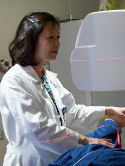Morphologic features of magnetic resonance imaging as a surrogate of capsular contracture in breast cancer patients with implant-based reconstructions Journal Article
| Authors: | Tyagi, N.; Sutton, E.; Hunt, M.; Zhang, J.; Oh, J. H.; Apte, A.; Mechalakos, J.; Wilgucki, M.; Gelb, E.; Mehrara, B.; Matros, E.; Ho, A. |
| Article Title: | Morphologic features of magnetic resonance imaging as a surrogate of capsular contracture in breast cancer patients with implant-based reconstructions |
| Abstract: | Purpose Capsular contracture (CC) is a serious complication in patients receiving implant-based reconstruction for breast cancer. Currently, no objective methods are available for assessing CC. The goal of the present study was to identify image-based surrogates of CC using magnetic resonance imaging (MRI). Methods and Materials We analyzed a retrospective data set of 50 patients who had undergone both a diagnostic MRI scan and a plastic surgeon's evaluation of the CC score (Baker's score) within a 6-month period after mastectomy and reconstructive surgery. The MRI scans were assessed for morphologic shape features of the implant and histogram features of the pectoralis muscle. The shape features, such as roundness, eccentricity, solidity, extent, and ratio length for the implant, were compared with the Baker score. For the pectoralis muscle, the muscle width and median, skewness, and kurtosis of the intensity were compared with the Baker score. Univariate analysis (UVA) using a Wilcoxon rank-sum test and multivariate analysis with the least absolute shrinkage and selection operator logistic regression was performed to determine significant differences in these features between the patient groups categorized according to their Baker's scores. Results UVA showed statistically significant differences between grade 1 and grade ≥2 for morphologic shape features and histogram features, except for volume and skewness. Only eccentricity, ratio length, and volume were borderline significant in differentiating grade ≤2 and grade ≥3. Features with P<.1 on UVA were used in the multivariate least absolute shrinkage and selection operator logistic regression analysis. Multivariate analysis showed a good level of predictive power for grade 1 versus grade ≥2 CC (area under the receiver operating characteristic curve 0.78, sensitivity 0.78, and specificity 0.82) and for grade ≤2 versus grade ≥3 CC (area under the receiver operating characteristic curve 0.75, sensitivity 0.75, and specificity 0.79). Conclusions The morphologic shape features described on MR images were associated with the severity of CC. MRI has the potential to further improve the diagnostic ability of the Baker score in breast cancer patients who undergo implant reconstruction. © 2016 Elsevier Inc. |
| Keywords: | magnetic resonance imaging; medical imaging; diagnosis; regression analysis; logistic regression analysis; multi variate analysis; multivariant analysis; diseases; statistically significant difference; muscle; graphic methods; feature extraction; wilcoxon rank sum test; statistical methods; reconstructive surgery; implants (surgical); shrinkage; receiver operating characteristic curves; methods and materials; learning algorithms; higher order statistics; least absolute shrinkage and selection operators |
| Journal Title: | International Journal of Radiation Oncology, Biology, Physics |
| Volume: | 97 |
| Issue: | 2 |
| ISSN: | 0360-3016 |
| Publisher: | Elsevier Inc. |
| Date Published: | 2017-02-01 |
| Start Page: | 411 |
| End Page: | 419 |
| Language: | English |
| DOI: | 10.1016/j.ijrobp.2016.09.041 |
| PROVIDER: | scopus |
| PUBMED: | 27986345 |
| PMCID: | PMC5541677 |
| DOI/URL: | |
| Notes: | Article -- Export Date: 2 February 2017 -- Source: Scopus |
Altmetric
Citation Impact
BMJ Impact Analytics
MSK Authors
Related MSK Work














